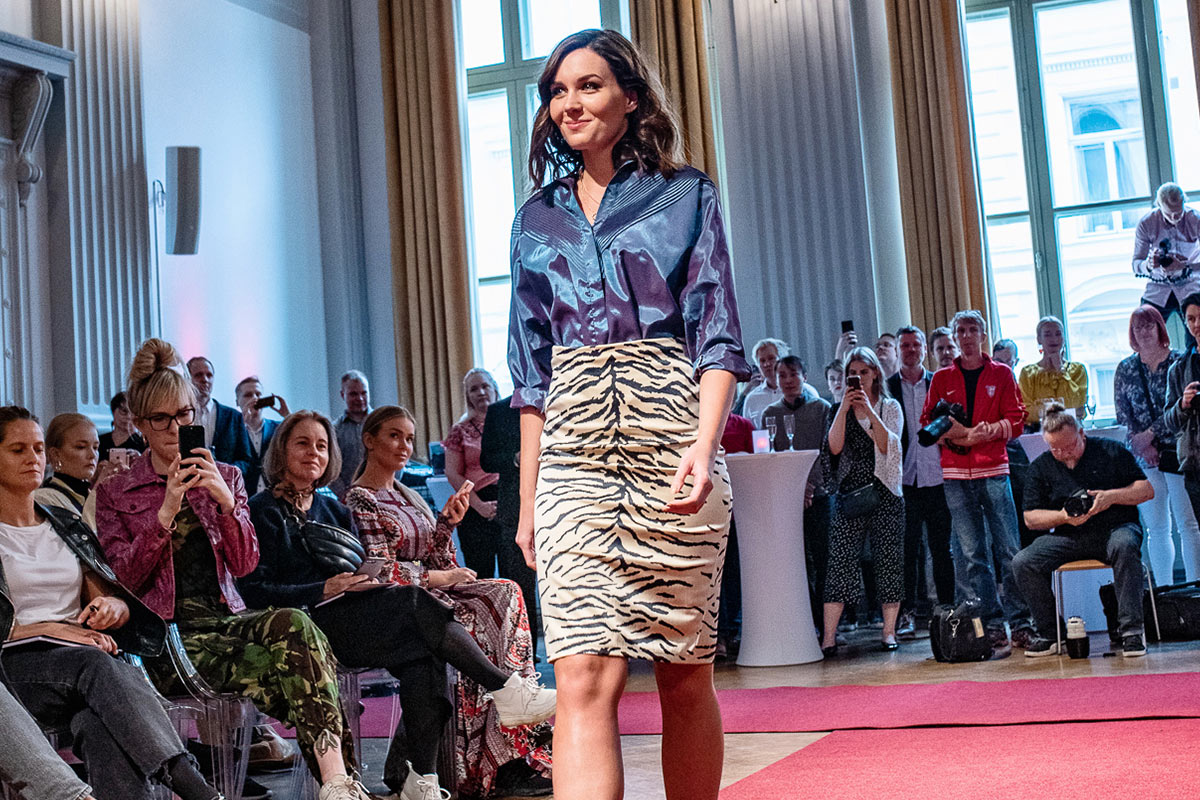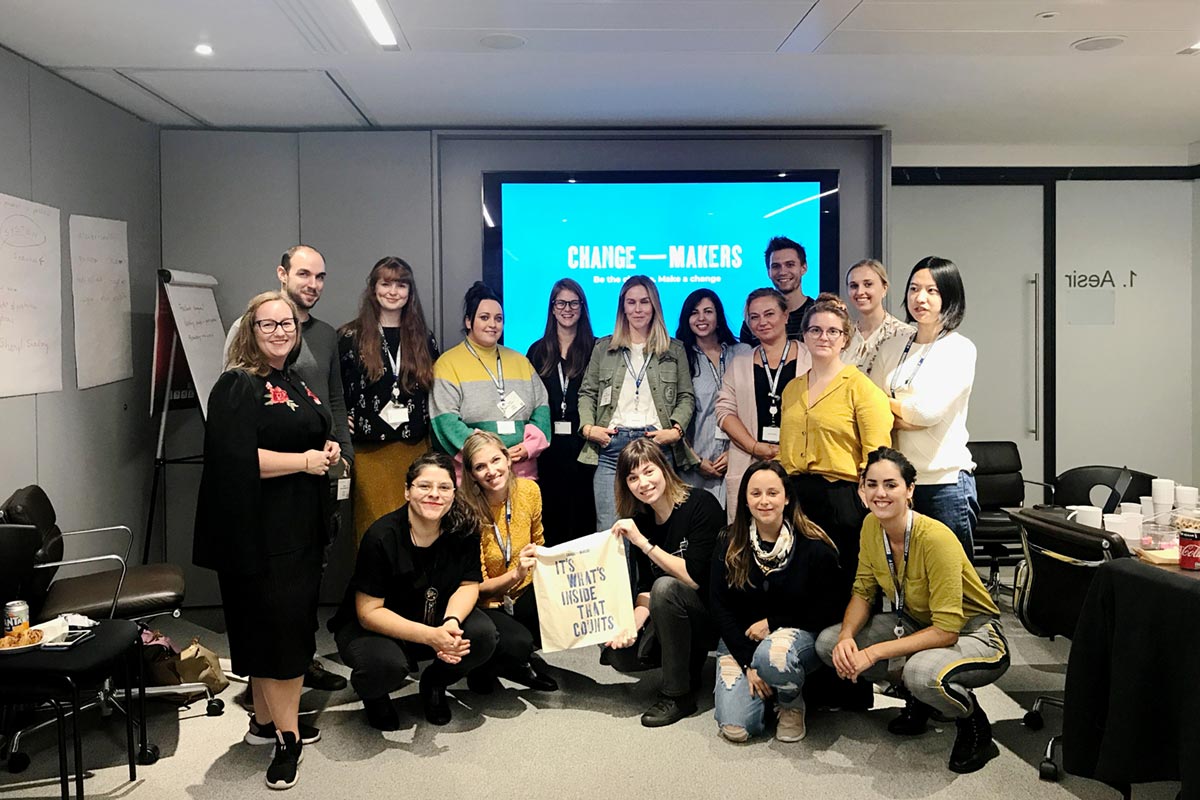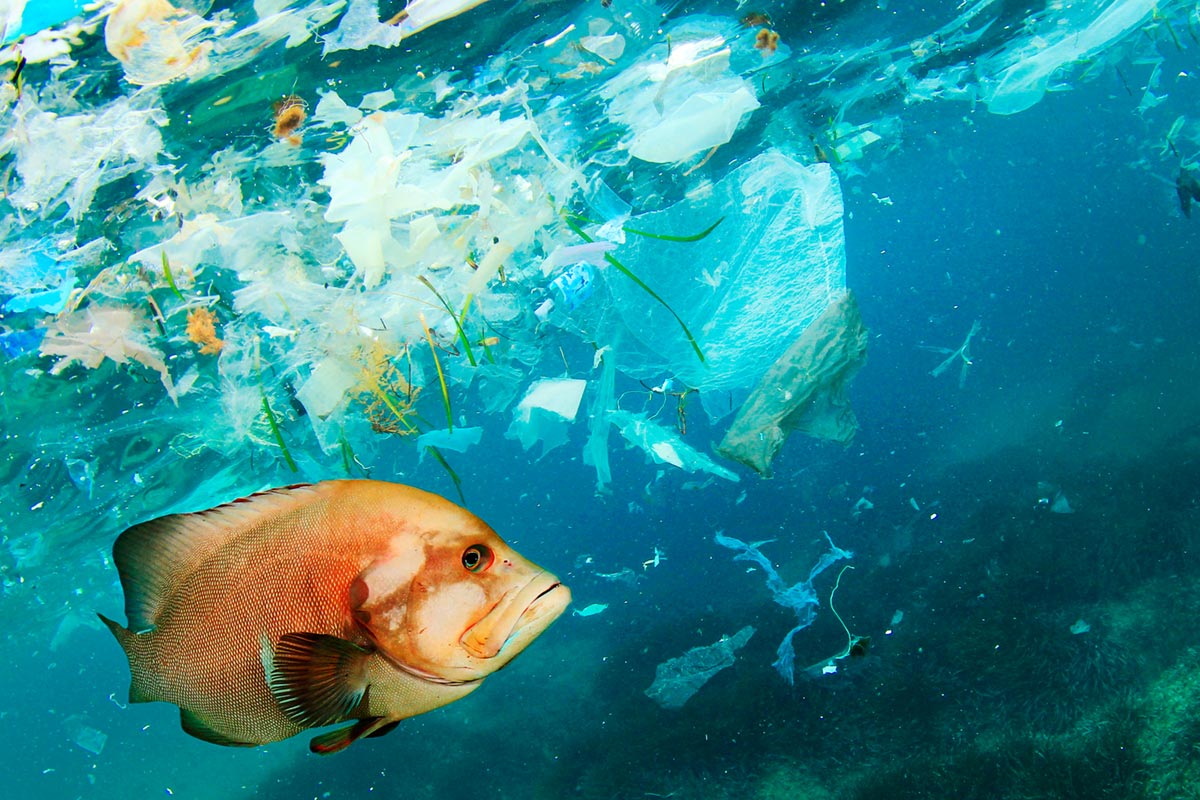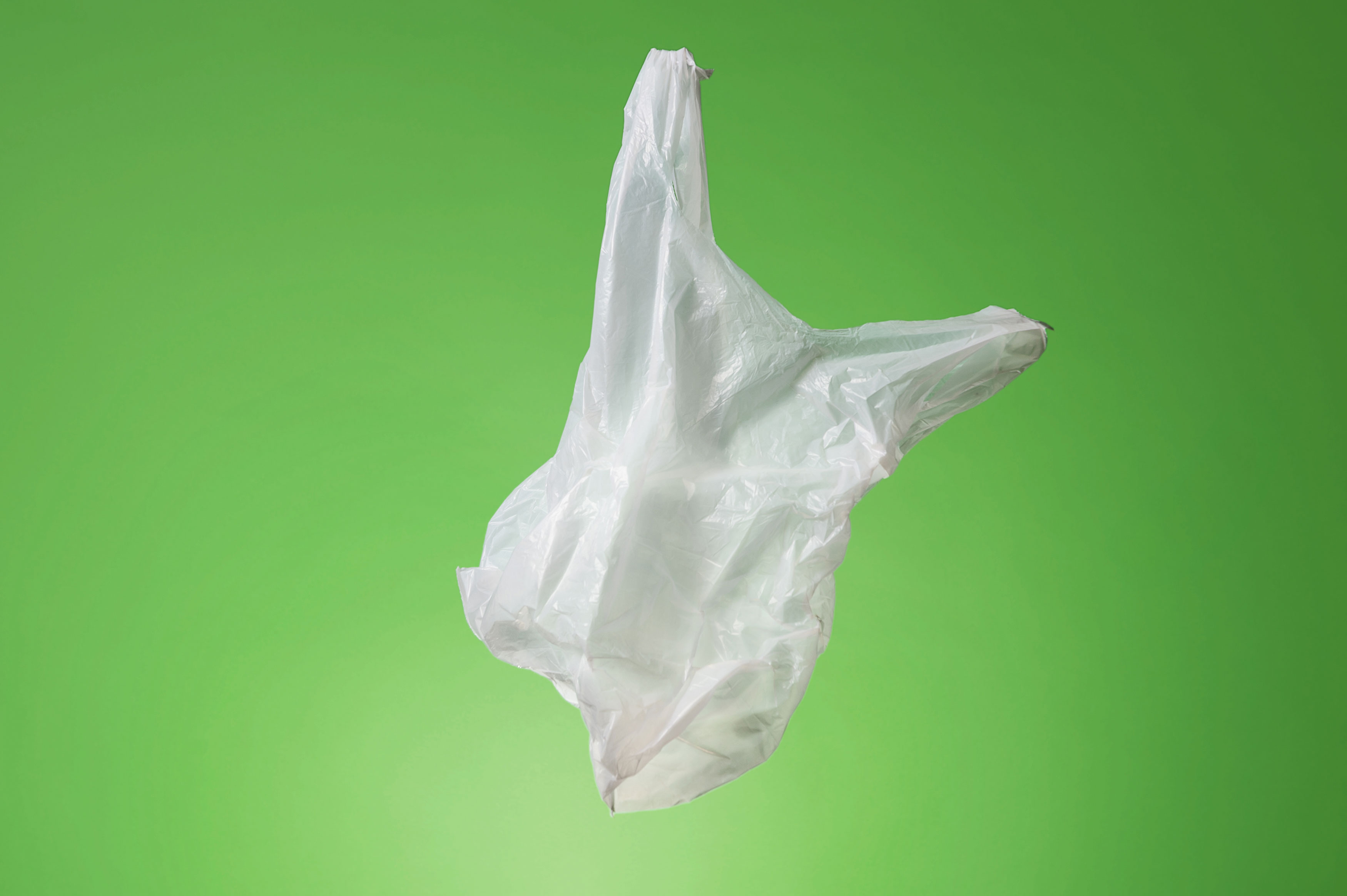Would you rent a skirt?

Would you rent a skirt?
Will fashion shame be the needed tipping point for the fashion industry to become sustainable? There are already several alternatives to shopping new clothes.
Flight shame has recently been on everybody’s lips. Should we feel ashamed or not? Should we stop flying to force the industry into a transformation mode? Or should we climate compensate until the airline industry itself finds the right technology to reduce their emissions? Will the industry even bother without a push? Will shame lead to anything positive at all or will it just drive us into climate depression?
According to the United Nations Environment Programme (UNEP), 3 percent of the global emissions come from the aviation industry. But there is another industry that is an even worse emitter and should worry us even more than flying – the textile industry. It comprises 10 percent of the global emissions (UNEP) due to its long supply chains and energy intensive production. In addition, it consumes a lot of natural resources. But to stop using clothes is not an option like stop flying.
According to a report from the Ellen MacArthur Foundation (“A new textiles economy, 2017”) more than USD 500 billion of value is lost every year due to clothing underutilization and the lack of recycling. Less than 1 percent of material used to produce clothing is recycled into new clothing. A scary 73 percent of textiles end up in landfills or are burned.
This is the dark side of the fast fashion industry. UNEP estimates that more than half of fast fashion produced is disposed of in a year. The fashion industry is designed to make you feel “out of trend” after one week and the clothes will probably fall apart after one washing. The overall quality of clothing has decreased tremendously, causing producers to make a lot more in order to get the same amount of goods to sell. Research from BBC Earth shows that three out of every five t-shirts bought today, will end up in the bin within a year.
The industry works in a linear way
Needless to say, this has a huge negative impact on Mother Earth. So, what can be done to turn this around? Obviously the fashion industry must change the way it operates. The textiles industry works in an almost completely linear way today with take-make-dispose: large amounts of non-renewable resources are extracted to produce clothes that are often used for only a short time..
Waste and pollution are largely a result of the way we design things. By changing our mindset to view waste as new materials we can ensure that waste and pollution are not created in the first place. This is the beauty of the circular economy and it is a new way to design, make, and use things within planetary boundaries. It’s the model of reduce-reuse-repair-recycle and in this way, clothes, textiles and fibers are kept at their highest value during use and then they re-enter the economy afterwards, never ending up as waste.
There is progress in the industry today. There are initiatives trying to change to other types of material than the culprit polyester, a polluting plastic made from fossil fuels. Like Spinnova in Finland that turns cellulose and waste streams into textile fiber without harmful chemicals. They state that “wood looks good on you”.
You also have the joint initiative between Fashion For Good and C&A to develop C2C Gold Certified™ jeans. The jeans have been designed to last longer, they can easily be recycled and they are made in a way that is better for the environment and for the health of garment workers.
We need to change the way we think
But it’s far from enough and if the customers want the fast fashion, why should the industry be motivated to change? Just think about how easy shopping is today with the online options and the retailers fighting to give us the best price. They definitely need help – and a bit of fashion shame could be it.
Shame or not, we need to change the way we think about our clothes. We all have practical, emotional and social reasons for both wearing the clothes and buying them. It’s not necessarily easy to change. Let’s say you got emotional motives and use shopping as therapy. Or you are the practical type that need something to wear and want a bargain on Black Friday. Or you wear clothes to demonstrate values and try to fit in and do your shopping based on social pressure.
What if you taste for fashion and your reasons for wearing and purchasing could be satisfied with clothes rental. You could end up changing your wardrobe whenever you want. You could even rent out your own clothes that you are tired of and earn money that could be spent on renting more clothes. Or what if you have a black belt in shopping and could really find those incredible deals by shopping secondhand online or even join a secondhand fashion show for inspiration? You could change your black belt into a green one.
All these options are available today and more are in the pipeline. Fjong in Norway is renting out women’s wear and help you rent out your own clothes that you have grown tired of. Even brands like H&M and NA-KD are looking into rental options today. And there are marketplaces facilitating secondhand trade like finn.no, blocket.se and tori.fi and many others.
So, think again the next time you are in need or in mood for shopping. Could you do it in another way? Do you really need it? Could you repair or redesign what you already have? Could you buy it secondhand or rent it? Can you swap or share with someone? Could you reduce what you already have by giving it away or sell it to someone? And if you can’t – at least make sure you buy quality clothes with a long life and with the possibility to recycle into new clothes. And always ask the retailer for information on what the garment is made of, how long it lasts and if it can be recycled. They may not be able to answer or even provide you with a quality product, but at least you put a message through that they got to start sharing information with their customers and rethink the way they produce their clothes.

Britt Nilsen
Head of Sustainability
Years in Schibsted
22
My dream job as a child
Doctor
How do we tell the climate story?

How do we tell the climate story?
Hope or despair – what stories about climate change will drive change? Swedish papers Aftonbladet och Svenska Dagbladet tried different ways – when interest from the audience is stronger than ever.
Is it time for a new chronology? Ante and Post Greta.
Before the teenager had made youth all over the world go on strike, the interest in climate journalism was weak. Now, it’s the other way around. Readers and viewers can’t have enough.
By now Sweden is the world champion in climate journalism, at least if we include Greta Thunberg in our blue and yellow team. Her engagement has made people around the globe listen and willy-nilly start reflecting about their own lifestyle. Greta Thunberg’s speech at the UN Climate meeting in New York in September was, in the Guardian, being compared to Abraham Lincoln’s historic and rhetorically perfect speech in 1863 on the Gettysburg battlefield.
“How dare you?” will forever be associated with the Swedish teenager who dared tell off the power, the elite and the politicians in front of the whole world. After that, many people felt an urge to make their voices heard.
On Twitter, almost a million messages were posted in the 24 hours following the speech and her 17 postings on Instagram during her journey to the US had 12 million interactions, more than double the number president Donald Trump received in the same period, according to Retriever, a monitoring firm.
Things are going well now. At least for the journalistic climate coverage which after years of going down now is as self-evident to Swedish media people as covering sports, politics or the stock exchange. In 2018 there were 85.000 articles written with the climate in focus, twice as many as in 2014 and the forecasts continue to point upwards. In the first half of 2019 there were nearly 60.000 pieces, which is more than the full year 2016.
A kitchen table dilemma
Of course, everything sticks together. Where the debate is, there are the readers. When Donald Trump is belittling Greta Thunberg, the enthusiasm is sky high. Her call to strike becomes a kitchen table dilemma for parents both in Sweden and the USA. Scientists are underlining the need for change of lifestyle in the Western world to diminish our ecological footprints and possibly reach the target from the Paris Conference xof 1.5 degrees increase in global warming
Alarms are sounded. Debating is intense. Garbage is being sorted. Guilt and shame. Engagement and numbness. Facts galore.
What is it then that we in the media should tell the public? Is it the dystopian stories in the wake of climate change or should we focus on the innovations that can stop the global warming ? Is it hope or despair that drives change? And should it affect what is being written and presented by the media?

Photo: Magnus Wennman
All of Schibsted’s newspapers have an extensive climate coverage. In Sweden both Aftonbladet and and Svenska Dagbladet have put big efforts into storytelling journalism also outside the feverish news stream. Both feature series “Their Planet-the Climate and our Guilt” and “Climate change-the innovations that lead the way” have attracted much attention without surfing on the Greta Wave or, favoring anybody or to practice planless noise-making.
The Aftonbladet reporter Erik Wiman and photographer Magnus Wennman went west to tell what happens to people in the wake of climate change and how the next generation is affected by our lifestyle. The project starts in what was once the ashes of the bone dry little town of Paradise in California.
“We arrived in Paradise just as men and women dressed in white protective clothing went about in search of human remains. Those were almost surrealistic days. A town that, within a few hours, ceased to exist.
We built our story on a woman who had a child in the night before the fire came. With the baby in her arms she drove her car through the flames, out of the town. It is one of the most shattering witness story I have ever heard”, Erik Wiman says.
The result is a brilliant piece of journalism bearing witness of how global warming is a burning issue which should be reported from different perspectives to grab a hold of people and to be made visible. The picture language is unique; combining feature photography and art. On the body of the baby a silhouette of a forest is projected. A blood circulation that was nearly extinguished before life had begun. The pictures remind us of who must take the blow of our choices: the children.
What was it that you primarily wanted to describe in “Their Planet”?
“I regard climate journalism as any other kind of journalism. I always look for people who can give a voice and a face to a figure, an event or a phenomenon that I want to highlight”, Erik Wiman says.
Svenska Dagbladet has partly chosen another path. Instead of following the tracks of climate change the photographer Magnus Hjalmarson Neideman and I have been looking for possible solutions that could stop the global warming; the innovations that might be able to save our planet as we know it. That took us among other places to the worlds largest thermic sunpower station in Sahara and to Iceland where carbon dioxide is being sucked out of the atmosphere and then pumped back into the bedrock where it is mineralized in a matter of just a few months. In the assignment the moving pictures have been in focus. Therefore, each journey has, in addition to an extensive feature story, also resulted in a short documentary.
“It is so much more complicated and time-consuming to be taking pictures, filming and flying a drone simultaneously But it has gone fantastically well and we have really reached out with our films, not least to younger viewers”, says Magnus Hjalmarson Neideman. And he adds: “Then it is a nuisance to always have to have the camera on a tripod. But these are new times and if you want to be sustainable you just have to
hang in there.”

Photo: Magnus Hjalmarson Neideman
Fantastic photos, creative reporting, films and graphics that are tastefully presented on the net seems to be a way of describing this global development besides the ordinary reporting of news. Because now, as the percentage of carbon dioxide in the atmosphere has reached its highest level in 800.000 years and the average temperature of the earth is continuing to increase, more and more people are beginning too understand that it is important, urgent and necessary to understand the complexity in order to be able to act and not just succumb to flying shame or the burden of sorting the garbage.
My understanding of the force in telling good stories, the importance of also nurturing hope came to me as I was trying to console a little girl who had watched a nature film where all the animals were under threat. They were emaciated, vomiting plastic and succumbing to draught. What was her future going to be like? Was there any point at all in carrying on if a planetary garbage dump was all that was left? Her tears were flowing and I had no good answer.
Do I have that now?
After having travelled the world, studied everything from the problem with batteries and renewable sources of energy to the challenges for the transport sector, climate-smart food and, on top of that have talked with many foremost researchers, an answer has gradually appeared.
Resilience ought to be the 11th Commandment when the planet has a fever and when our eco systems are on the verge of collapse.
Actually, the voices have become more and more coherent after decades of sounding the climate alarm. Resilience ought to be the 11th Commandment when the planet has a fever and when our eco systems are on the verge of collapse. We still don’t know where the tipping point is, when the systems are bolting and there is no way to stop the warming regardless how we try. But no one can claim that they did not know where we were heading. On the day it happens, if it happens.
But I am not the one you should listen to, but, just as Greta Thunberg says, you should listen to the researchers. And they increasingly agreeing on what is happening and why. At the same time the technology is there. Millions have recently demonstrated the will of the people globally. The economic incentives are getting more and more clear. The media are reacting and upgrading – while politics is still lagging behind in some places.
Abraham Lincoln’s famous speech, The Gettysburg Address, established that all men are created equal, that the country shall have a new birth of freedom with a government of the people, by the people, for the people and that the people shall not perish from the earth.” Greta Thunberg declared that the world is about to wake up and the change is on the way.
The task for journalists is always to describe the world around us, to put questions, tell stories and hold the forces of power responsible. But to compare Greta Thunberg to Abraham Lincoln! Yes, how dare I?

Erica Treijs
Reporter, Svenska Dagbladet
Years in Schibsted
22
My dream job as a child
Pippi Longstocking, or dolphin trainer
People trends in short

People trends in short
Media businesses keep looking into new solutions, models and experiences to create better offerings. These are three interesting trends, summarized by Schibsted Daily Editor Mikaela Åkerman.
Hyper-personalization
No two readers are the same. That is the approach of the idea to hyper-personalize users’ media experience. With the help of modern technologies such as artificial intelligence and machine learning, publishers can experiment with all sorts of parameters to increase engagement and satisfaction with their products. It can be things like finding the best time of the day to deliver content to an individual reader and learning which articles work best to draw readers in. It can also be about testing different layouts and designs, identifying the best channel of communication, and discovering the most effective frequency to deliver content to them. It all comes down to getting to know habits, interests, and preferences of readers as a way to increase loyalty and thereby, hopefully, accelerating subscription growth and reducing churn.
Multi-channel experience
The trend of creating a multi-channel experience, or omnichannel experience, is neither new nor limited to the media industry. All kinds of brands, from retail to banking, are looking to create a seamless user experience across different services and platforms. Most businesses today have marketing campaigns, a website, a blog, and other social network channels alongside their core product. The key, some experts argue, is to make sure they work together and form an integrated, consistent experience. Companies looking to use this technique are encouraged to align their messaging, goals, objectives, and design across each channel and device to enhance their marketing and service efforts.
Editionbased publishing
Forget endless streams of constant news updates. Editions are back in. As a contrast to the fast-paced news flow, which can feel overwhelming at times, readers are looking for boiled-down, summarized, to-the-core news products. News apps with a limited number of stories and newsletters alike are rising in popularity. The behavior goes hand in hand with the observation that readers are increasingly involved in micro-moments of news consumption. Our time is limited, and so is our attention spans. Readers want to feel updated and accomplished in a short amount of time, whether it is while waiting for the bus, standing in line, or having a few moments over during lunch. Studies also suggest that frequency is one of the highest predictors for retention. In other words, making sure people use your service often can be more important than how long they use it for or how deep into it they go.
Don’t worry – it’s getting better

Don’t worry – it’s getting better
Looking at pure facts, the truth is that the world is getting better in many ways. But this is news that seems hard to establish. Anna Rosling Rönnlund and her partners in Gapminder are devoted to spreading a more complete picture of the state of things. “It’s not that we are driven by being optimists. We’re presenting facts that scientists agree on. And we’re frustrated that people believe that things are worse than they are”, Anna Rosling explains.
Gapminder is a foundation, known to many through Hans Rosling, Anna’s father-in-law, who passed away 2017. Hans traveled the world to present unique visualizations of facts on global economy, health and demographics. He had many fans, including some of the world’s most famous people – like Al Gore, Larry Page, Bill Gates and Barack Obama. Anna and her husband Ola Rosling founded Gapminder together with Hans and are now continuing the mission: to work towards a fact-based worldview that everyone can understand.
How many of you would have guessed that 90 percent of all girls in the world are going to school or that the share of people living in extreme poverty has halved over the last 20 years? Not many, probably. Gapminder has tested a lot of people, and a great majority have misconceptions of the world. That also goes for professors and experts. Anna believes that fragmentation is one reason.
“Some blame media, but their job is to report on things that are not normal. We think that schools are the ones that need to fill in the gaps.” At one point Gapminder was invited to Google to work on making the data accessible. “But we realized that it was still hard for people to find it and to put it into a context. That’s when we knew we needed to work with schools”, Anna says. So Gapminder has hired two teachers to better understand teaching needs. And their new book Factfulness was written with a highschool teacher in mind. They have also made tutorial material for the book.
“In the long run we need to find better ways of teaching social science in school.” In the end Anna is in fact an optimist – at least when it comes to data and information. “We have access to more data than ever. We just don’t know how to process it yet.”
At war in social media

At war in social media
Social media has become the arena for an information war, where private companies offer fake net identities to use for influencing. This is how the world of bots and propaganda works, writes Karin Pettersson and Martin Gelin in their book “Internet är trasigt” (The Internet is Broken).
Alabama is in the Deep South of the United States, where racism is at its liveliest. It was here that Donald Trump held an open meeting in the fall of 2017 and chose to vent his spite on the black American football players who, instead of honoring the flag during the national anthem, knelt in protest against racism. “Wouldn’t you love to see one of these NFL owners, when somebody disrespects our flag, to say, ’Get that son of a bitch off the field right now’”. Trump’s words were clearly intended for his core voters in Alabama. His comments exploded in social media and later also in the traditional media. The topic was ideal for Trump, who feeds on war on cultures, polarization and wrath.
But it was also perfect for the Russian president Vladimir Putin. That could be noticed in real time on the surveillance site Hamilton 68, which is tracking more than 600 Russian propaganda accounts. The Russian propaganda apparatus loved the story and did everything it could to enhance it. The accounts were tweeting like mad, making up new hashtags and spreading every possible bit of the story.
They most likely contributed to the topic attracting so much attention and growing so big in the public domain for such a long time. The Kremlin is very astute at propaganda, as it were. And the structures that Adrian Chen and Jesikka Aro identified in 2014 have only grown more powerful and efficient since then. Around the world, countries are building social media armies in order to protect their own populations from foreign influence or efforts to influence them in a certain direction – alternatively, as in the case of Russia, to control the debate at home and abroad.
“Around the world, countries are building social media armies.”
There is an example of cyber defense in Estonia where they, after having been subjected to heavy IT attacks in the spring of 2007, formed something that resembles a digital home guard: “Estonian Cyber Defense League”. Ordinary people who, in collaboration with the armed forces, counteract Russian propaganda. In a report about Russian influencing operations in the Baltic states, Stratcom (Nato’s strategic communications center) showed that 85 percent of all tweets in Russian about Nato came from bots.
One of the reports produced by Oxford Internet describes the possibly hardest thing to get at, but is becoming more frequent. It has to do with private companies producing fake net identities which then can be used to influence what impact a company or political idea has on the net. An example from Poland reveals how a marketing and communication firm over several years created 40,000 false identities, all of them with real names, IP addresses and personalities. Each one of these “persons” then has several accounts in different social media, offering the possibility of making a heavy impact for someone who can afford it.
15 fake accounts at a time
The theory behind this business is called “false amplification”, to give material and opinion a distribution that they would otherwise not have. The way it works is that real persons manage false accounts, as many as 15 accounts at a time. The trick is to be very careful to use real photos and make the accounts look “real” so that they are not detected by the filters at the social media companies that try to weed out fake identities. Then these fake accounts are used to write in comments boxes, Facebook groups or on Twitter. They use VPNs or false IP addresses and because they are so cleverly masked they become practically impossible to detect, both for the social media companies and for the world around us. This in turn creates safety and distance for the buyer of the service. The strategy applied by the companies is not to inundate social media with their message and get hashtags trending, but much subtler. It is about influencing opinion leaders, including journalists, politicians and activists. This is done by infiltrating important Facebook groups, writing comments and interacting directly with people who are important to reach. The aim is to influence these people, making them believe that the false identities truly believe in what they argue for.
Still many people, including journalists, believe that what you see on social media expresses the will of the people or mirrors the population, but without carrying out qualitative research it is very hard to draw any conclusions as to what it means when certain topics are trending or not on social media.
n the fall of 2017 Facebook, Twitter and Google were summoned to the US Congress to testify on how their platforms had been used by Russia in order to influence the election. The testimony from Facebook showed, among other things, Russian advertisements. In Pennsylvania, one of the states where the result of the election was unclear, the Facebook account “Being Patriotic” posted ads for a demonstration that was going to gather “miners for Trump”. The ad was aimed at male voters. “Donald Trump has said that he is going to give miners their jobs back” was the message. He had not said that, but that didn’t bother Moscow. Actually, it emerged, after an internal investigation at Facebook, that the ads were a part of a propaganda push controlled and paid for by Russia. Trump won Pennsylvania with a margin of less than 45,000 votes.
A frightening naivety
The weaknesses of the internet have been used by countries for several years. In many places, however, there is a frightening naivety in this field. This also goes for journalists who still are too uncritical when referring to the content of social media – regardless of the fact that the far right has organized Twitter storms for years, with the aim of influencing the media and the public opinion. Simply put, social media is not a place where the interests and views of people are reflected in a neutral manner. It is an arena for organizing, chatter, entertainment and information war. It is also a world where those with the loudest, most polarizing and most controversial opinions make the heaviest impact. In many (Swedish) newsrooms the awareness of influencing campaigns and the need for fact-checking and verification has increased. But in other places there is still a great naivety concerning the propaganda war of the new age, and what role the media outlets themselves risk playing if they don’t understand the new rules of the game.
Disrupting the information ecosystem

Disrupting the information ecosystem
We’re living in a new reality, where economic inequalities, climate change, migration flows and technological disruptions are shaping the world. It’s also a time of strong men and of the rise of authoritarianism. We tend to talk and worry a lot about Donald Trump, but it’s not only him. There’s Erdogan in Turkey, Orban in Hungary, Duterte in the Philippines, and Putin in Russia. And many others.
And there’s a fundamental question I’ve been asking myself the last years: Where does all this rage come from? In my former job as Political Editor-in-Chief at Aftonbladet I could feel the rising anger in a very concrete way, in my inbox and my social media feeds. Year by year, the level of hate and threats and aggression grew. I am an economist by education, and my instinct is to look for answers in the economy; disrupted labor markets, globalization, people being left behind. All of these factors are important. But as I traveled a lot in Eastern Europe last year, in Hungary, Poland, the Czech Republic, the story still just didn’t add up. These are countries with high growth and low unemployment. Despite that, the rage, the explosive media and political climate was the same as in the US, the Philippines, Turkey and yes, in Sweden.
Something has gone wrong
The level and intensity of rage just does not seem proportionate to the underlying, observable changes in economy and culture, as historian Anne Applebaum put it when I interviewed her in Poland last fall. The X factor seems to be how today’s internet and social media are shaping our public discourse. I used to be a fan of Mark Zuckerberg. Or at least of the tools he built. But something has gone wrong.
The problem at the core of this is that the content that’s most misleading or conspiratorial is what’s generating the most engagement, and that’s what the algorithm is designed to respond to. The stronger you react to the content you see on Facebook or YouTube, the more likely you are to remain on the platform. And the longer you stay, the more money they make from your data. In this way, the tech giants’ business models create the economic incentives now driving outrage, disinformation and polarization.
Tech giants distort competition
In today’s world, the logic of the attention economy overlaps with political forces with the stated aim of undermining liberal democracy. This is disrupting the ecosystem for information and challenging the ethos of journalism. But there is more to this story. The tech giants are also disrupting our economic structures. We see them growing data monopolies, using that advantage to distort competition. Google is pushing its own products with the power of its massive search engine. And Facebook is rolling out its own marketplace that the users cannot avoid. Their dominance is hurting jobs, innovation and our basic ideas of fairness and competition.
Change and pressure need to rise on many levels. From consumers, citizens and politicians. We need to understand how economics plays into this, the logic of the attention economy and the business models. Because at this point the sheer size and power of these companies are a threat to how we organize our societies. The good news is that the time is right and we see reactions.
Like from Margrete Vestager, the Danish EU competition commissioner. Or, as the Financial Times calls her, the “slayer of big tech”. Vestager has ruled that Apple needs to pay more taxes and has twice heavily fined Google for illegal behavior. GDPR and privacy is part of the backlash, as is the copyright vote in the EU. The world is slowly waking up and starting to realize what values are at stake.
Schibsted has a role to play
In the end this is about standing up for what we believe is important, and the truth is that companies like Schibsted can play a role in all of this. Schibsted has been careful in the past not to go all in on the platforms. We have kept the relationship with our readers and users in our own hands, to a large degree. We are small compared to the giants, but we are not owned by them – and we have a history with legacy. We are in the middle of this perfect storm in these pretty dramatic times and it’s a challenge, but honestly it’s also exciting and interesting.
Promoting diversity from the inside

Promoting diversity from the inside
In 2017 the #metoo campaign propelled gender equality and diversity conversations to the forefront of organizational debates worldwide. Since then the various benefits of creating a diverse and inclusive workspace have been widely discussed.
Schibsted, with its international Marketplace portfolio, has always had a naturally diverse culture. But as a company, we want to do even more. That is why diversity and inclusion became a topic of high priority in 2018. From the beginning it was clear that creating a cultural shift wouldn’t be easy, and that in order to achieve it we would need to invite advocates and influencers across the globe.
In October 2018 Change-Makers was born. 16 individuals across eleven countries came together to share, shape and build a movement of change. Change-Makers is not a traditional diversity and inclusion program. It’s a community that believes in creating change from the inside in order to transform our workplaces into spaces where differences are embraced, and everyone feels empowered to realize their full potential. The vision for driving change is twofold. On the one hand, we aim to encourage our community to empower each other. We do this through different tactics such as soft skills development, workshops on diversity, career planning, etc. At its core, Change-Makers is about identifying and solving root cause problems.
On the other hand it’s about organizational change. We believe that this new community will be a key pillar in creating workplaces that are bold enough to tackle real problems such as maternity and paternity leave policies, attracting (and retaining) more women in tech and embracing the benefits of having diverse teams. No one ever said change was simple, but having an organization that supports its individuals and communities is the first step towards creating a future we can all be proud of.
Elianne Mureddu
Caroline von der Mosel
Trends in Brief

Trends in Brief
“Why is it not working?” seems to be one of the most asked questions in every meeting room. Many companies claim that they will deliver a “one-click” solution, but some are thinking even further. Earlier this year, Microsoft showed off a 360 degree camera and microphone, specifically designed for meetings.
Meeting rooms of the future
“Why is it not working?” seems to be one of the most asked questions in every meeting room. Many companies claim that they will deliver a “one-click” solution, but some are thinking even further. Earlier this year, Microsoft showed off a 360 degree camera and microphone, specifically designed for meetings. The camera can detect anyone in the room and throughout the meeting, and the microphone transcribes everything they say, regardless of language. Microsoft has also added AI that listens in on the meeting and reacts to certain words and phrases, sending out notifications to participants who, for example, promised to book a meeting. Amazon’s Alexa has a similar setup, and can also check that all the tech is working beforehand.
The legalities of the gig economy
With companies like Uber, TaskRabbit and Postmates, the gig economy got a new face. Workers are encouraged to join the services and work whenever they want, wherever they want, which might sound good to many. However, in reality, the “no full-time contracts” business model has been criticized for hurting workers’ rights. When Uber pays way less for their drivers, it makes it impossible for competitors to keep up without lowering their own drivers’ salaries or adopting the same business models. Supporters call it a revolution and point out how cheap a taxi ride has become with Uber, but the opposing side has already managed to have Uber’s original business model banned in a long line of cities, including London.
How to make your hires smarter
Removing names and pictures from CVs was just the first step. In an effort to remove biases in hiring, big tech companies have found new ways to filter out talent. The startup GapJumpers, which collaborates with Google, has created a software program that facilitates blind auditions solely focused on an applicant’s skills (like on The Voice). The company has found that this increases the number of female applicants and employees, which is something Google has had a big problem with before.
Another startup in this field is Textio, which helps companies write job descriptions with less gender-associated words. There are also job sites that think outside the box, like recruitment marketplace Search Party, which only shows employers anonymous profiles with just enough information to make an informed hiring decision.
Ellen Montén
Move over, millennials – gen Z is here

Move over, millennials – gen Z is here
In 2015, millennials overtook both baby boomers and Generation X, becoming the largest share of the US workforce. But who is the new generation after the millennials and what can we expect from it?
Generation Z is typically defined as those born between 1995 and 2009, and we are already discovering that as businesses we may need to alter our approach to recruit, lead and market to this new generation. Generation Zers outnumber their millennial predecessors and they will likely not have just one career, but instead alternate between different careers, transiently. Money is often not the main object but instead the human and social connection, where they get to work with an empire of young people doing cool stuff. For Generation Z, it’s Snapchat, Instagram and Whisper rather than Facebook, Twitter and selfies that characterized millennials. “We absorb information instantaneously and lose interest just as fast”, reports a soon to be graduate. She is very concerned about her brand and more importantly her privacy having seen her older sibling be overly generous in how much he “posts on Facebook”. This is why she prefers Snapchat where images disappear as fast as they arrive.
Children of a post 9/11 world
So, what are the major differences between the millennials and Generation Z? Generation Z’s outlook is shaped differently, they have grown up in a post 9/11 world and in an era of economic volatility. Single sex marriage is now legal. The UK is on its second female prime minister and the US has had its first African American president and all of this is taken for granted. Without overgeneralizing they seem to be more conscientious, hardworking and mindful of the future world. They were raised by Generation Xers, who also experienced times of equal volatility and who value safety more highly. A Sparks and Honey trend report asserts that, as a cohort, this new generation appears more “mature and in control”. What do businesses need to be aware of in their approach to recruiting Generation Zers that may be subtlety different compared to previous years? “Subtle” is the key word here, as many of the elements below are not necessarily at odds with what we know of our millennials.
- Even more technology driven. Our Generation Zers have different expectations of a workplace, fully enabled by technology.
- Even more global. All businesses have the capacity to be global with virtual teams that create new levels of workforce flexibility. Despite Brexit and the US presidential election having us believe in the rise of nationalism, our Generation Zers will value diversity and inclusion as vital elements for growing businesses and societies.
- Entrepreneurial. This generation is “multi-potential” and therefore contributing to our growing gig economy – which may pose problems for corporate culture creation as we look to distinguish our businesses from others in the growing war for talent.
- Prudence and pragmatism. Growing up in global recessions with increased student debt, this generation is aware of the need to develop relevant skills that businesses will value in the workplace and in return they expect structure, professional development, mentorship and career advancement – and fast!
- Communication. Over 50 percent of our Generation Zers value face to face communication over other forms. This is in sharp contrast to the millennials so perhaps as employers we will see an increased capability in this area.
- Disruption. In a world where hackers are respected, they see the word “disruptive” as a more positive characteristic that should be encouraged.
- Less focused and split-tasking. Shorter attention spans will likely disrupt current workflows. How work is allocated and completed in a multi device environment will need to be considered by businesses when designing future roles and defining business processes.
“Less self centered and entitled, and instead collaborative, accountable and eager to learn.”
I am constantly impressed at how graduates seek to make a difference and assume ownership of ambitious projects. They are less self centered and entitled, and instead collaborative, accountable and eager to learn and contribute to the business agenda. Although some future aspects may be sharper in relation to Generation Z, there are many traits that they share with their predecessors. They both assimilate information and networks much quicker than previous generations, they care deeply about ethical leadership in relation to the environment and society.
Changing the voice of sports

Changing the voice of sports
In the fall of the year 2000 Aftonbladet revolutionized Swedish sports journalism, as the paper became the first in the country to publish a daily sports supplement. The recipe for success? How about pink paper, fake assignments, and social media?
The year 2000. What do we remember about it? Bill Clinton was the President of the United States of America, Playstation 2 was introduced and Britney Spears was on top of the singles list. Some things feel like yesterday, others like an eternity ago. Today it is hard to imagine what the media landscape and media habits looked like just after the turn of the millennium. When internet was something fairly new, social media did not even exist and smartphones could only be seen in sci-fi films. There was no place to watch television – except on the TV in the living room. All Swedes interested in sports surely have some sweet memories of the Olympic games in Sydney where Sweden won four gold medals; Swedish successes that were reported in the first sports daily, Sportbladet. Already back in the 90s there had been plans for an extended sports coverage at Aftonbladet, but the sports editor at the time, Lasse Östling, can still remember the frustration he felt as he was walking to work to fill a few sports pages.
A historic swedish victory
“I remember with horror when I went to the editorial office one evening after Sweden had beaten England at Råsunda Football Stadium in an important qualification fixture. Fredrik Ljungberg had just had his breakthrough, this was a historic Swedish victory and I had only six pages in total to work with, and all the other stuff was supposed to fit in there as well; horse trotting, ice hockey training matches and much more, whatever it was. I remember asking the editorial management how I was supposed to produce decent coverage of a victory that was the talk of the nation?
After some years, in the early 1990s, with poor attendance at sports events, Swedish audience numbers had begun to increase again. The appearance of commercial sports TV channels sparked a new interest. This was the time when the idea of starting a new daily Swedish sports paper was born. “There was a happy, party-like mood on the Swedish stands” Östling says. “The old men in the top management began to understand that we should have a product that was matching those interests and not just something that was dismissed to some silly pages far back in the evening paper.” In 1996 Aftonbladet had overtaken its fiercest rival Expressen in circulation figures. At its widest the gap was almost 100,000 copies a day, but in the late 1990s Expressen had begun to lose in and the editorial management felt that something had to be done. The decision was to put increased effort into covering sports. Fearing that the competitors might get wind of the new plan everything had to be done in secret.
“Instead of a couple of sport pages a day there was now going to be at least 16 pages.”
Aftonbladet started hiring new, young sports journalists but to avoid any unneccesary attention they were not assigned to the sports desk – Sportbladet did not yet exist – but to other desks at the paper. Some of the sports columnists-to-be were put to work for a month with the Sunday edition and not even those who worked at the sports desk at the time knew that they were going to move to Sportbladet.
The pink paper was a signal
Another move, which was made just a couple of months before the launch, was to start printing on pink paper resembling the respected Italian sports paper La Gazzetta dello Sport.
The pink color was a signal saying that the paper was going to take readers interested in sports seriously. Instead of a couple of sport pages a day there was now going to be at least 16 pages every day in a separate supplement. On May 8, 2000 Sportbladet was launched but the reception was cool among people in the trade. Many asked themselves how Aftonbladet was going to fill 16 sports pages (later to become 32) every day of the year. But fairly soon it turned out that the large space opened up for another type of sports journalism and a different kind of journalist. Over night there was suddenly room enough to tell stories rather than just report results and events on the pitch. Now the coverage was about the football culture in Moscow or what football in Bucharest meant for the Roma population of Romania.
“Sportbladet proved some things that few people had dared hope or think”, says the Sportbladet columnist Simon Bank, who has been with the paper since 1999. “First, that Sweden was large enough to have a daily sports paper. Second, that Sweden on top of that had enough curiosity to appreciate journalism and reporting, that is not only about the closest, most audience-catching topics. And be read and admired for it”, Bank says.
Thanks to this, not only was a new audience coming to the sports pages, but also a new brand of journalists. “Erik Niva and Johanna Frändén had perhaps been possible 30 years ago but they would not have been writing in the same style, about the same topics. Now they are among the best writers there are in Sweden, regardless of category”, Bank says. 18 years after the launch the pink sports pages are still there, just as the basic values of quality, curiosity and courage. But more and more energy is used for the digital traffic and there are plenty of challenges.
“It has been a fantastic journey and it’s still going on”, says the present editor of Sportbladet Pontus Carlgren. “We develop and change all the time. Today we are not only producing a daily paper. We are working with social media, videos, podcasts and an IT development that can be absolutely decisive. The tone of presentation that was typical for Sportbladet still exists but can now also be heard clearly in all our social media. In our new organization we have three staff members working with social media. All three of them have a background as subeditors at the paper, and that is not a coincidence”, Pontus Carlgren says.
A pioneering spirit
Several of the profiles at Sportbladet have been awarded prizes for their journalism and much of the playfulness and pioneering spirit that distinguished Sportbladet 18 years ago still lives on, both in the editorial room and in the marketing department. In the spring of 2018 4,373 footballs were dumped all over Sergels Torg in the center of Stockholm as a reminder of the long, warm – and pink – World Cup summer that lay ahead.
Wanted: 1,000 bags with plastic junk

Wanted: 1,000 bags with plastic junk
More than 15 tons of plastic is dumped into our oceans every minute. Today there is a quarter of a kilo of plastic in the ocean for every five kilos of fish. This is why Finn.no started the campaign Havplast – ocean plastic – and by that, took another stand for the environment.
It all started with a stranded whale, outside Bergen in Norway in early 2017. When it was cut open researchers found that it was filled with plastic and the problem with ocean litter became obvious to the whole of Norway. The public learned that if we continue like this, there will be as much plastic as fish in the ocean in 33 years, according to researchers. “We believe that brands can be activists and we want to engage our consumers in responsible consumption – and help life below water. Norway is one of the countries in the world with the longest coastline. The problem is real for most Norwegians and it’s crucial that we act”, explains Hanne Lill Johnsen, Marketing Manager. The idea that came up was also within their core; to create a classified category for ocean plastic on Finn.no. Then they posted an ad: “We want to buy 1,000 bags with marine litter for 10 USD a bag”. Everyone that answered the ad received a bag and was asked to fill it with marine litter and post a new ad on Finn.no, who would then buy it. The 1,000 bags were gone in hours. So, Finn bought 5,000 more. They were gone in days. They then invited other brands into the project. One bank bought 2,500 bags. Ikea set up containers where people could deposit their bags. In the summer of 2017, thousands of Norwegians took to the beaches to help clean up the coastline.
100 school classes helped out
In 2018 Finn wanted to do something new. “We teamed up with a kids environmental club, Miljøagentene, and reached out to 5th graders to help us collect plastic from the beaches”, says Hanne.
5,000 kids did an impressive job, collecting and learning about the plastic problem. More than 100 school classes contributed. They all got 20 bags each which Finn bought. All together plastic worth 30,000 USD was sold.
For Finn the ocean plastic project is much more than a single campaign. Being a marketplace for secondhand trade, the environment and the climate issue is directly connected to their business. “Our core is about reuse – and that is part of the solution for our climate. And a part of a more circular economy.” And just as people want to help collect ocean litter, more and more people also want to contribute to a more sustainable world. And this is what all the users at Finn.no and other marketplaces are doing when buying and selling used stuff.
Secondhand sales save on plastic
To make this more visible, Finn is also part of a Schibsted project called The Second Hand Effect, where they measure the environmental benefit from secondhand trade. The idea is to investigate how much material and emissions can be saved through secondhand trade, if each secondhand product replaces the production of a new one. Then this is recalculated into greenhouse gases. In 2017 ten of Schibsted’s marketplaces, all over the world, participated in the project. When adding up the result, it turns out that the users on these sites saved 21.5 million tons of greenhouse gases. And to connect the dots – they also avoided 1.2 million tons of plastic to be produced – when instead buying and selling used things. “The Second Hand Effect shows us that small actions can make a big difference for the planet”, says Communication Officer Kristine Eia Kirkholm.
A new space age

A new space age
After decades in the shade space is back on the agenda. Private entrepreneurs are pushing the limits of exploration, speaking about living on Mars and exporting our dirty work. And we tend to listen – filled with hope, existential fears and imagination.
June 27th 2018, northern Sweden. We gathered outside on the porch to watch the “blood moon of the century”. The whole family was there for the event, with cheese, snacks, wine and candy for the kids. As a bonus we got to see the Red Planet rise above the treetops. It was a rare occasion. The gathering of the family, that is. What is the thing with space? Why does it capture our imagination and emotion so much? After a relatively quiet phase in the public eye, one thing is for sure: space is back on the public agenda! In force. Let us look back together on space technology, space politics, space music and spacemen.
My first truly emotional encounter with space was a good 25 years earlier. Our infantry unit was practicing night operations when the sky suddenly lit up green. Wow, the major brought green flares instead of red! Not quite. At the edge of space, at the Kármán line 100 kilometers above our astonished faces, the magnetosphere shielded us from the electromagnetic onslaught from outer space. The Northern Lights interrupted our battle plans, and the major, in an uncharacteristic turn of events, called off practice and took the squad for a hike up the nearest hill to get a better view of the show. It was the freakiest of shows.
Ground Control to Major Tom
Take your protein pills
And put your helmet on
Ground Control to Major Tom
Commencing countdown
Engines on
Check ignition
And may God’s love be with you
– Space Oddity, David Bowie, 1967
Don’t be afraid of the man in the moon, sang David Bowie on his self titled debut album, two years before Neil Armstrong took one giant leap for mankind in 1967. The pop icon extraordinaire was never far from space and launched his next album and Major Tom into pop history only a month ahead of Apollo 11. Music was for the longest time one of the few ways we could approach the unfathomable space, and Space Oddity was a spectacular record.
Music and space intersected on another spectacular disc: the Voyager Golden Record. This gold plated copper record with a catalogue of human culture, biology and ambition was sent into deep space on Voyager 1 in 1977. Complete with a map of who we are, our DNA and a map to our home, The Mix Tape of the Gods, floats through nothingness as humanity’s invitation card. A shout into the void, desperately beckoning: is anybody out there?
We humans have been looking to the stars for millennia, at least, with this existential question. One of the earliest recordings of space travel and extraterrestrials is “True History” by Lucian of Samosata in the 2nd century AD. In the novel he visited the moon and found a people at war with the people of the Sun. Italian astronomer Giovanni Schiaparelli observed “canali’ on Mars in 1877 which led to instant speculation. In 1896 Nicolas Tesla suggested that we could contact the people of Mars using his wireless electrical transmission system, and actually thought he had detected a signal at one point. Our fascination with space has always been there, and has evolved over time.
Early space exploration in the 1950s and 1960s was more practical than emotional and focused on the challenge. John F. Kennedy’s speech in 1962 articulated the moon as a beckoning frontier and a pioneering challenge, ripe for capture by a nation with pioneering in its blood. The global competition with the Soviet Union was ever present.
But why, some say, the moon?
Why choose this as our goal?
And they may well ask, why climb the highest mountain?
Why, 35 years ago, fly the Atlantic?
We choose to go to the moon!
We choose to go to the moon in this decade and do the other things, not because they are easy, but because they are hard.
– John F. Kennedy, 1962
The moon is not a destination, it is a direction, continued Apollo 11 astronaut Mike Collins. In 1989 George Bush Sr. said the ultimate goal was not simply to go there and go back, but to go there and go on. Well, we have not gone back. Perhaps Collins and Bush would be disappointed that no man has set foot on the moon for over 40 years? It makes sense to me. We have been there, done that. Why go back? There is no actual utility of going to the moon, is there?
While NASA no longer sends astronauts to the International Space Station, it’s private entrepreneurs who are pushing the limits of space exploration, and making us look to the sky again. They articulate their motivation for the hard, risky, and in most ways unrewarding enterprise quite differently. Elon Musk, SpaceX founder and CEO, claims that space exploration is a necessity for the survival of mankind. When (not if) World War III breaks out our best bet to save humanity is to ensure “there’s enough of a seed of human civilization to bring human civilization back”. That seed should be planted on Mars. The other Space Baron billionaire, Jeff Bezos, sees space as a place to do our dirty work – mining, manufacturing, and recycling – in order to preserve Earth as a cleaner and nicer place to live. Bezos foresees space stations with millions of workers.
Yet, the most inspiring sales pitch for space is not these rational arguments. It is Elon Musk’s knack for quirky PR. Letting Jonathan “Jonah” Nolan, co-creator of Westworld, edit a short video where SpaceX’s newest rocket, the Falcon Heavy, launches a Tesla roadster into space to the tunes of David Bowie’s Life on Mars, is nothing short of communication genius. We get to see cheering crowds of people gathered around Kennedy Space Center, children with binoculars, a dummy astronaut named Starman, and a Voyageresque message etched into the circuitry: “Made on Earth by Humans”. As to the why of this movie Elon Musk tweeted:
Why Falcon Heavy & Starman? Life cannot just be about solving one sad problem after another. There need [sic] to be things that inspire you, that make you glad to wake up in the morning and be part of humanity. That is why we did it. We did [it] for you. – Elon Musk on Twitter, 2018
So, space is our hope and our existential fear. A muse for the greatest pop icons. Space is also our challenge and frontier, worthy of our finest engineers. It is certainly back on the agenda, in part thanks to bold entrepreneurs with spectacular vision and intelligent machines. What more? It is without doubt politics. Not everyone is pleased with space exploration and the undertones of going to Mars to save the human race. The Apollo program had its own share of critics. The main point was that spending billions of tax dollars on rockets was a sad priority when there were more pressing needs here on Earth – inequality, poverty, hunger, war. Gil Scott-Heron quipped in the introduction to Whitey on the moon: “I wanna give credit where credit is due”.
Was all that money I made last year
For whitey on the moon?
How come I ain’t got no money here?
Hmm! Whitey’s on the moon
Y’know I just ‘bout had my fill
Of whitey on the moon
I think I’ll send these doctor bills
Airmail special
To whitey on the moon
– Whitey on the Moon, Gil Scott-Heron, 1970
The present day launch of Falcon Heavy, and the accompanying live stream watched by millions, earned opprobrium in new ways. To some, the privatization of space exploration signals billionaire escapism in a very tangible way, while the poor masses are left on a boiling Earth. Although it might be a bit unfair to demand of engineers Bezos and Musk to solve Earth politics when politicians cannot.
The Cold War space race is over, and clearly winning space ahead of the Russians is perhaps not as motivating. Still, the United States of America is getting a Space Force, according to president Donald Trump! The idea of a Space Force, despite it sounding like the prologue of a sci-fi film, has been floating around since the late 90s. I suspect the reason to bring it to the forefront now is that it still captures the minds of voters, telling a story of power, strength and technical advancements.
One thing is for sure. Space is not good business. Financially speaking it is nothing short of a black hole. The US space programs have cost some 500 billion dollars of present day tax money. Critics say private space projects only seem to surface when men, who had space on their mind as boys, come into significant money. Or government. Musk and Bezos have already been mentioned. But did you know Paul Allen of Microsoft also has a space company; Stratolaunch Systems Corp? Richard Branson is chairing his Virgin Galactic. Bezos, currently the richest man on Earth, says he divests a billion USD of his Amazon stock every year to fund his space venture Blue Origin. As we ride the fumes of the longest bull market in history, there is certainly an element of newly created private riches looking for increasingly long shot investments. And what is farther out than space? Supporters admire the fact that these private fortunes are diverted into something useful for mankind. I guess it depends on how you define useful, in contrast to for example the Bill and Melinda Gates Foundation.
To the man on the street space is first and foremost entertainment. Few things capture our imagination as the Star Wars saga, and the story permeates back into reality. For example, in October 2007, NASA launched a space shuttle carrying an original lightsaber from the Star Wars set into orbit. You already know the SpaceX line of rockets are named Falcon. There is also the Yoda purpurata, a species of acorn worm. Ronald Reagan’s Strategic Defense Initiative, a shield of lasers and missiles to intercept incoming missiles, was quickly labeled “Star Wars”. In England and Wales almost 400,000 people stated their religion as Jedi on their 2001 census forms, surpassing Judaism and Buddhism. In Brighton, England 2.6 percent claimed to be Jedi.
There have been several crucial technological advancements lately. Tales of mechanical men, golden robots and clockwork automatons turning from fiction into science, through the pioneering work of Alan Turing in the 1950s to today’s deep learning algorithms. You see, an essential part of deep space exploration is robotics. Sadly, we humans cannot keep up with our own imagination and ambition in the flesh, despite the Final Countdown. To build Martian bases, mine asteroids and explore lightyears of deep space, intelligent machines are a necessity. Oxygen-sucking, carbohydrate-eating mensch just don’t cut it. We need robots that perform complex tasks autonomously, and even replicate themselves. Today, as artificial intelligence is increasingly becoming a reality and less of science fiction, even the most audacious of plans seem achievable. This is perhaps the clearest driver of the return of space to the agenda. The simple fact that we can do it.
We are programmed just to do
Anything you want us to
We are the robots, We are the robots
We are the robots, We are the robots
We’re functioning automatic
And we are dancing mechanic
– We are the Robots, Kraftwerk, 1978
And the fact that new technologies inspire new achievements was clear to another musician, creating a mega hit. Rock band Europe’s The Final Countdown almost never made it out of Joey Tempest’s teenage drawer. He was experimenting on the synthesizer Korg Polysix when he found the famous riff. “Some people think that tech and music are unrelated. But new tech feeds new ideas”, he claimed in an interview. Much later when the song, to the band’s surprise, became an instant hit, Joey commented: “It is so simple, borderline banal, very close to the line.”
Close to the Kármán line perhaps? New tech feeds new ideas. And new ideas feed new tech. That’s not rocket science. What remains to be seen is if we are all leaving together. Or if most of us stay grounded until the next blood moon of the century.
We’re leaving together,
But still it’s farewell
And maybe we’ll come back
To Earth, who can tell?
I guess there is no one to blame
We’re leaving ground
Will things ever be the same again?
It’s the final countdown
– The Final Countdown, Europe, 1986
Meet our people

Meet our people
In Schisbsted we have thousands of employees all over the world, doing so many different things. Find out what some of them are working with right now.
“I like it when things are a bit hard”
In March 2018, a new personal finance service was launched from Schibsted growth; Hypoteket. Hypoteket offers digital housing loans – without involving any bank, and using Bank-ID for signing. “Many customers in Sweden are a bit unhappy with their banks, who have been making a lot money from them for a long time. We are a transparent and competitive alternative”, explains co-founder and CEO Carl Johan Nordquist. The transparency includes the same interest rate to everyone, and clarity in terms on who can get a loan. Pension funds and insurance companies are financing the loans.
And for them Schibsted has been an important partner behind the startup. “We need access to large amounts of capital so having a stable and trustworthy partner has been crucial.” The team worked on the project for two years before launch and Schibsted was involved from the start. The founders had already worked with another personal finance idea – Bolånegruppen – that didn’t take off. “I’m an engineer, but also a typical entrepreneur. I like it when things are a bit hard. And I guess it takes a bit of naivety to do things like this, otherwise you wouldn’t dare taking the risk”, he says. The challenge now is that the personal finance market is exploding, and others are starting to offer the same kind of services. “But we have a good head start, and it has gone really well so far.”

Years in Schibsted: 2. I look forward to: That The Killers haven’t given up, and are recording another album.
“We call our people advocates”
Roberto La Rosa has turned customer relations and customer insights around at Subito. Now decisions and development are based on their input. When Roberto joined Subito, customer care was outsourced. He brought it back in-house. “We call our people advocates – because they’re representing the customers’ voices”. The team talking to customers are challenged to read between the lines and really understand what lies behind a question. Then the journey to improve processes or the product begins. Every two weeks the customer team meets with the product team to give input. “When I started to speak to customers in 1999 I had the feeling that I knew things the management didn’t. So part of my mission is to close this gap, and to speak about how the customer center creates value.”

Years in Schibsted: 3. I look forward to: Automating and innovating the customer experience even more.
Simple rules to giving feedback
Dana Lin is an Employee Engagement Manager at Schibsted Marketplaces, where she looks after the employee feedback cycle and helps the team to build its culture – and she’s really into feedback. “I’d like to help people get into the habit of seeking and providing feedback on a continuous basis, and to feel comfortable doing so.” She is starting off with a semiannual feedback cycle in Schibsted Marketplaces, to provide the leadership with insights to build a better workplace. But she believes that what really makes a difference is feedback on a daily basis. “There are some simple rules to follow: ask if the person to whom you want to give feedback wants it, focus on the behavior instead of the person, and assume best intent.”

Years in Schibsted: 1/2. I look forward to: Touring around Italy and France with my mother!
Hiring talent gets tougher
There’s a big change going on in recruitment. Now the candidates are in power. The best candidates are getting multiple interviews and finding work quickly – they are picking and choosing employer. “This changes the whole recruitment process, and how we present ourselves. We need to meet new demands from the future workforce”, says Lena Berlin Stålhammar, Head of Talent Acquisition in Schibsted Media. How a candidate is experiencing a meeting is crucial, not only when it comes to getting the job or not, but to the brand itself. So Lena and her team are now implementing a tool that is measuring talents’ experience, giving them input on how to improve. And they are offering a training program to leaders on how to handle recruitments.

Years in Schibsted: 6. I look forward to: Being a part of future proofing recruitment in Schibsted by working more data driven.
Millenials worry about online integrity

Millenials worry about online integrity
Millennials are aware that the data they leave behind is valuable – and they worry about how it is used. Future Report has compared their online habits in Sweden, France and Spain.
Millennials are the first generation to grow up surrounded by mobile technology and social media. They live in the moment and have been described as unattached, connected, free and idealistic. They also do their business in a time where personal data is currency. So, what are their view on integrity and privacy online? In this year’s edition of Future Report we find that Millennials in Sweden, Spain and France do care about their online privacy and that they do worry about integrity online.
67% of Spanish and French millennials in our survey said that they worry that the information they provide on social media can be used to influence political views.
Millennials’ digital lifestyle includes a higher number of friends on social media profiles, they share their location with friends and family, but are less likely to share their location with businesses and employers. They are also more likely to delete social media profiles entirely. Millennials are known to have little trust in companies and brands. They don’t trust companies like Facebook, even though they interact with them and share personal information with them.
In the wake of the unexpected outcome of Brexit and the presidential election in USA, a discussion about social media, fake news and the use of psychographic data became heated. Combined with the upcoming GDPR regulation, digital habits related to data security are even more important to understand. Our study shows that a majority of the millennials in Sweden, France and Spain are worried about the fact that traces you leave on social media are used to direct messages in order to influence elections.
Careful about traces
Millennials are aware that the personal data they provide has a value. A majority in all three countries say they worry about what states and companies knows about them.
Overall, millennials are careful about the digital traces they leave. This is confirmed when we ask if they have changed the settings on their smartphone in order to protect their personal integrity. Many claim to have done so. And when it comes to ad-blockers, the vast majority say they use them.
Read the full report:
Future Report 2017 Final Version
The art of doing good

The art of doing good
Enough of ruthless exploitation of nature and people! Enough of overconsumption, fast fashion and waste! The time has come for a new way of having a good life, where we all try to do better.
She was engaged in the refugee crisis in the wake of war, she knitted as part of a social movement, she was part of an international network. She shared her belongings with neighbors, minimized her waste and on vacation she did not stay at hotels but with friends. She celebrated humanistic values such as equality. She had her own career. She grew her own vegetables in her backyard and every summer she’d make lemonade and enjoyed her home-farmed salad. In the fall she harvested and saved for the winter. She had one shopping bag and of course she baked her own bread. She ate less meat and more greens, more in season and less processed food. And yes, she kept bees. A true urban hipster 2018. But no, she was my grandmother, born in 1897.
“There is a genuine will to take a stand and live a truly good life”
Several of the strong behavioral trends we see today such as the sharing economy, social engagement rather than materialistic frenzy, celebrating an environmental responsible way of living, are really just signs of a huge sobering up for the western world. Add purpose driven businesses, the former sourdough mania and recent urban beekeeping bonanza, and there’s a clear pattern. We heard the wakeup call. And there is a genuine will to take a stand and live a truly good life; to have a positive impact, however small, in the choices we make.
When political forces fail
For too long we have indulged in ruthless exploitation of our common resources, for too long we have neglected the harsh reality of the state of our planet. Today, this is so evident that even the political agenda is dictated by these insights.
And when political forces fail to deliver on that responsibility, large corporations step in, as in the case of Trump and the Paris climate agreement. Several of the largest US companies, such as Apple, Exxon Mobile and Ford declared they would uphold the agreement or continue to cut greenhouse gas emissions, disregarding the president’s decision. Tesla’s Elon Musk and Disney’s Bob Iger both left Trumps advisory councils as a consequence. Mr Iger is now being mentioned as a possible presidential candidate after also calling Trumps decision to rescind Obama’s program to allow children of paperless immigrants to remain in the US “cruel and misguided”. All of a sudden the boss of Disney is the voice of social responsibility.
But we no longer necessarily turn to politicians or established organizations to demand or make a change. We want to change the way we live our own lives, how we interact, work and consume.
“We are sort of self-curating our own life and we are very curious about how we can get more out of life. We basically want meaningful experiences,” stated the well acclaimed futurist Anne Lise Kjaer at TedxArendal in Norway recently.
When Kjaer Global listed the global trends 2020, one of them was “betterness”, in the report described as businesses and individuals joining forces to make a positive impact for the greater good of all by practices such as radical openness and social responsibility. Another trend on the Kjaer Global list was “enoughism” a term used to challenge the belief that the good life is dependent on consumption of stuff, instead we look elsewhere for new ideals to define a fulfilled life.
The good life-trend can be seen in diverse areas such as in the fundamental change in how companies attract talents – brands that give us meaning, are authentic and connect to strong values are attractive to the younger generation. The latest Deloitte millennial survey states that “opportunities to be involved with “good causes” at the local level, many of which are enabled by employers, provide millennials with a greater feeling of influence.”
And purpose is one of the strong drivers in the start up scene, young entrepreneurs not only want to be best in the world – they want to be best for the world. A responsibility more complicated than Mr Zuckerberg opted for as it turned out.
Eat what you buy
But living a better life is also about the many small things that have great impact, choosing to buy second hand or buying high quality products that can be mended – or saying no to the plastic bag you are offered to carry stuff home in.
Reducing the number of plastic bags is an international effort to save the oceans, the EU wants to decrease the number of bags to 90 (!) per person each year. Several initiatives and campaigns are already in place. When British Tesco started charging, 80 percent less bags were distributed. The Swedish initiative One Bag Habit showed a decrease of up to 70 percent. We obviously don’t need these bags and it’s an easy decision not to use them. If we do nothing, soon there will be more plastic than fish in the seas. And no turtles. So get a basket for your Saturday shopping, and more importantly: eat what you buy.
According to the EU 88 million tons of food are wasted every year in Europe – to a cost of 143 billion EUR. A third of all food produced globally is lost or wasted. An average restaurant in Europe produces more than 68,000 kilos of food waste every year. And most of it is perfectly edible. As a reaction The Ugly Food movement is giving the misshaped vegetables and bruised fruits of the world a new market instead of being dumped or rejected. French supermarkets have been required to donate all edible food to charities and shelters instead of throwing it away as in most countries. Some researches go as far as saying this is the solution to feeding the world in the future – we do not need to degrade to eating insects – we only need to use what we already have in a better way. Something to ponder on next time you think lunching on yesterday’s leftovers is not so hot.
Or you can make a change in the simple act of cooking spaghetti: Like photographer Judith Buijze from Amsterdam when she rediscovered an old household trick. She turned off the gas of her stove after boiling her spaghetti for only two minutes. She then left it in the pot with the lid on for another eight minutes and – voila!– the spaghetti was ready even though she had only used 25 percent of the gas required if she had followed the instruction on the package. She shared her experience on the social network Nudge, the information reached the CEO of the egg wholesaler Rondeel – and now the instructions on packages from Rondeel say that eggs can be boiled for only two minutes and then left in the hot water to get ready. Thus saving large amounts of gas or electricity.
Apart from being a social network Nudge is also a Dutch PR agency, specializing in changing behaviors within climate, energy and social sustainability. At the moment 60,000 activists are helping out, ready to influence their surroundings.
The skeptic might argue that all of this is for the privileged middleclass, comforting their own bad consciousness, and that these are all such small efforts that they won’t help. Fredrik Moberg, researcher at Stockholm Resilience Centre, says they do. “Of course there’s a risk of thinking that my small contribution doesn’t matter. But it does – not least as an example. We know that people are more willing to change habits and act if a friend or neighbor is doing so. And not least – politicians are carefully watching what their voters are doing.”
He also confirms the over all trend.
“There is a change, individuals and companies are taking more actions. And people are getting more and more aware. People don’t just act to be nice to nature.”
So, by living like your grandmother you might actually change the world.



